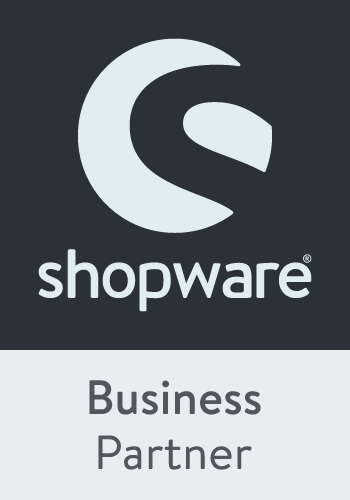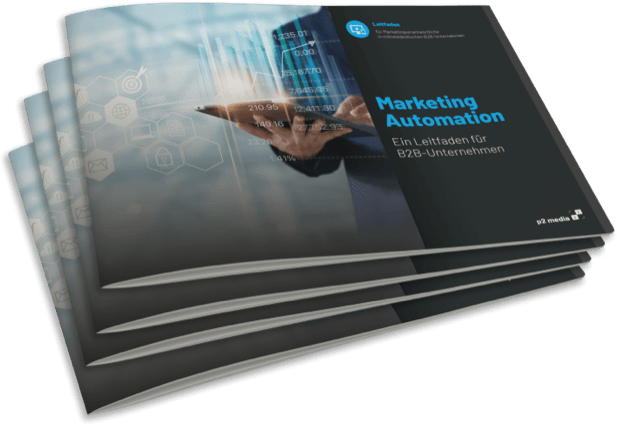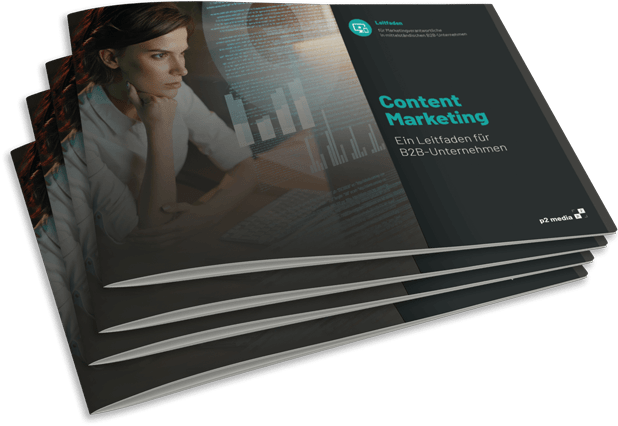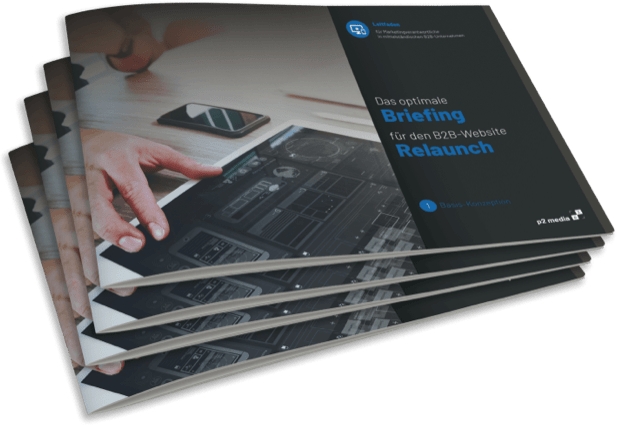E-commerce in the B2C sector has not only been the norm for years, but is also part of the expectations of (potential) customers. People who register the need or necessity of a new purchase of any kind primarily go online in search of the corresponding solutions. They count on finding the right information online, as well as opportunities to order the corresponding goods directly or to book services.
Increasingly, however, this expectation is also being transferred to the B2B sector - and in the meantime e-commerce in B2B is no longer a speciality either.
In the course of the study "B2B e-commerce 2020 - status quo, experiences and outlook", the research institute ibi research found that one in five B2B companies already generates more than 50 percent of its sales online. It is estimated that in 2025 more than half of all purchasing processes in the B2B sector will take place within B2B online shops or online marketplaces. A full 40 percent of buyers already prefer to order on the web.
The high economic relevance of B2C online shops as well as B2B online shops is beyond question! More and more companies are realizing this. Nevertheless, many companies still hesitate - which is often due to the primary hurdle of the right entry.
The basis for maximum useful e-commerce is always the right shop system and a methodically secure implementation of the online shop with it.
The Shopware 6 shop system has proven itself time and again to be the optimal solution for a large number of businesses, due in part to its API-first approach ("application programming interface") and its fundamentally good scalability.
What is Shopware
Shopware is a full-fledged shop software, which is currently available in version 6.
It follows the so-called API-first approach, which means that Shopware 6 offers the best conditions for linking with other systems or features that are important for e-commerce.
Compared to its predecessors, Shopware 6 is based on a completely new technological concept. Among other things, the possibility of access to several thousand extensions allows you to customize Shopware 6 to your needs or those of your customers.
In addition to many online shop plug-ins, there are around 50 interfaces to payment services and various merchandise management systems.
Headless commerce can also be implemented with Shopware 6.
With the latest version (v6), Shopware has evolved from a "classic" shop system to an e-commerce platform with the goal of providing users with maximum flexibility and giving their customers the ideal shopping experience.
What are the advantages of the shop system Shopware
In practice, Shopware 6 often proves to be the best option for companies - whether industrial or local retail - that need a small to medium-sized online shop with good opportunities for e-commerce expansion.
As one of the leading shop systems worldwide, Shopware 6 offers all the implementation options for front-end features that online shop customers expect today.
Furthermore Shopware offers an extensive rights and role management, quick orders, contingent and budget organization and a quotation management for sales representatives.
According to the company, Shopware will provide a suite for the most complex requirements of various B2B and B2C business models.
Shopware 6 offers the so-called experience worlds and other tools with which especially B2C companies can create visually as well as emotionally highly appealing shopping experiences.
Shopware includes a CMS and thus has a completely different focus on marketing than most of the competition on the market.
With its customizable experiences, Shopware offers users new possibilities.
In the experience worlds, among other things, layouts can be created via drag-and-drop and assigned to individual pages or page types.
This benefits B2B online shops in particular, where it is naturally extremely relevant to success to convey strong visual impressions and emotions.
Through API First and an enormous number of plugins, as well as the possibility to create individual additional modules, Shopware is highly expandable.
Especially for B2B online shops, but also for more extensive projects in B2C e-commerce, the diverse possibilities provided by the "Api First" approach, as well as the powerful management tools and content commerce features integrated in Shopware are highly interesting. Thanks to the API-first approach, Shopware is highly flexible and adaptable to virtually any e-commerce context. Thus, the system can be used as headless technology and typical processes in the online shop can be controlled and automated via API directly from CRM, ERP, PIM software or other tools.
Shopware is intuitive, connective, functional - and thus THE answer to an ever more complex e-commerce world.
The content commerce functions ensure that the creation and management of landing pages, category pages, product detail pages, listings and other important pages for maximum success in e-commerce are relatively easy and require no programming skills.
The goal of the Shopware developers was to create an intuitive usability. This means that Shopware 6 can be easily used even by smaller businesses and local retail stores that do not have an IT and/or marketing department.
What's new with Shopware 6?
Thanks to the API-first approach, through which all functions in the backend can also be used automatically via APIs, Shopware 6 is extremely flexible.
Ultimately, the system can be used for almost any use case.
A seamless integration of external systems, such as PIM, ERP, WAWI, CRM as well as ticket and support tools, can be carried out highly efficiently in Shopware 6.
In addition, the basic performance in the frontend and backend has been improved.
Using modern technologies, such as Bootstrap 4 and VueJS, the system is very well prepared for a possible future new or further development of your online shop.
In the completely new and "mobile first" designed backend, which is no longer based on the classic window concept, users find their way around much better. Everything looks tidier and clearer.
The backend also offers some new and/or enhanced functions. Particularly worth mentioning are the extensive rule system and the shopping worlds already described above. The rule system allows users to intuitively create highly complex applications - à la "customers who buy X get Y" - for which a programmer would almost always have had to be consulted in the past and with other systems. With the shopping worlds, users create highly appealing shopping experiences on several levels in no time at all.
Which interfaces (APIs) does Shopware 6 offer?
An API allows software and also hardware components to access certain functions of other software or hardware. Through such access points, different systems can communicate with Shopware 6, exchange data or pass commands.
The API-first approach that Shopware takes in version 6 means easier integration with other systems, applications, etc. for users or developers via - in this case - three REST APIs: the Admin API, the Sync API and the Sales Channel API.
The resulting architecture is highlyflexible, so it offers tremendous opportunities to extend the functionality of the system. API-First also means that all functions can be accessed via an API and not just a few.
Under these conditions, Shopware 6 can be connected to all conceivable systems that can be useful for e-commerce - such as marketplaces, accounting software, or an in-house merchandise management system.
The interfaces offer the opportunity to easily integrate an existing system landscape into a Shopware shop and to control it automatically via API.
Can I switch from Magento to Shopware?
Every change should always be well considered and strategically questioned, because not every system is suitable for every shop project. Thus, all shop systems bring different advantages but also disadvantages with them. Should you nevertheless flirt with the decision to switch from an existing Magento system to Shopware, the new Magento Migration Assistant offers the possibility to migrate the following data largely automatically:
What are the most important steps in creating an online shop with the Shopware shop system?
If you want to create a webshop with Shopware 6, you should definitely proceed methodically and precisely.
Therefore, read below the most important steps on the way to a successful Shopware 6 online shop.
Long before you take care of the - undoubtedly extremely important - aspects of the design, usability and marketing of your online shop, it is important to precisely assess your starting position and, based on this, set up a strategy for your e-commerce.
It is very important to define concrete goals and create a roadmap.
This is the only way to ensure a success-oriented implementation.
Ideally, you sell products that are hardly represented in online retail. Alternatively or additionally, you should focus on goods for which demand is particularly high.
The product range should definitely be defined at an early stage, as the orientation of the online shop strongly depends on it.
In the case of B2B online shops of production companies or service providers, it is of course already largely clear that the company's own products will be sold.
However, it can also be worthwhile here to think outside the box when it comes to offers and perhaps include additional, supplementary articles from partner companies in the online trade.
Your target group consists of your typical existing customers and ideal customers.
In an in-depth analysis, the first step is to identify certain characteristics of these. Based on these characteristics, it is possible to estimate quite precisely whether and to what extent corresponding people make online purchases. You then apply these findings to the orientation of your online shop - and in all areas, if possible.
Target groups are of course not only to be considered completely individually from industry to industry or business orientation to business orientation, but also with regard to the distinction between B2C and B2B. For example,B2C customers can usually be convinced very well by conveying emotions. Whereas B2B customers always decide much more rationally. Accordingly, B2C online shops are often well advised to focus on design, a modern look and uncomplicated language. In B2B online shops, on the other hand, functionality and clear facts are predominantly in demand.
In order to successfully operate e-commerce, you need to assess the existing market and transfer corresponding findings to your online shop.
At the base, it is important - simply put - to look at what the market and the competitors are doing and to deduce how it can be done better as well as which further efforts resulting from the market situation are likely to make sense.
Shopware 6 is the ideal solution for many companies that want to create an online shop. Before you finally decide on this shop system, however, you should carefully review your options.
When choosing the right shop system, the preliminary considerations that have been mentioned up to this point are of course extremely important. More precisely, these should already provide certain indications as to the scope of your online shop and how complex it needs to be.
Corresponding factors are decisive for the choice of the system. Of course, you must be able to meet all requirements with the future shop system. However, if possible, only those functions should be available that you really need in order to keep the processes efficient as a whole.
After choosing the shop system, start designing the shop structure. Ask yourself the following questions for the first draft:
- What is particularly important for customers when they enter the shop?
- Where does the menu need to be placed and what items does it need?
- Which product categories need to be divided?
When these facts are gathered and connected, you will automatically have a first structure on which you can build further.
The enormous competition prevailing in many e-commerce areas today requires intensive differentiation from the respective competitors.
Especially in B2C, only those shops that offer outstanding unique selling points (USPs) can hold their own in many business areas.
However, it is becoming increasingly rare for such USPs to be created solely through the product range.
Increasingly, it is a highly target-group-specific, memorable design, particularly fast shipping or direct, personal advice - perhaps via chat - that make the difference that is so important for success.
Shipping and payment are extremely important aspects in any online store context.
Prospective customers often bounce significantly if they do not find the preferred options - even at the very end of the checkout process.
Therefore, it is highly relevant not to rush the selection as well as the connection of payment and shipping providers. In both areas, reliability and speed are essential.
Ideally, you already record the shipping and payment requirements of your typical customers in the course of the target group analysis.
In e-commerce, there are actually an immense number of legal necessities and pitfalls.
These must be known and sufficiently considered in the online shop. Especially in terms of data protection and DSGVO, caution is advised.
Here, non-compliance with the relevant requirements can result in severe penalties. Only the advice of a specialist can provide security.
At the latest after completing the setup of your online shop, it is important to inform your general target group as well as possibly already existing customers that your shop is now online.
A strategically clever announcement is also very important in the long term in order to be able to maintain and expand the position you have once achieved on the market.
In addition to the perhaps existing addresses of existing buyers, through which you can address those directly, you should definitely use the possibilities of marketing and online SEO. Because as already mentioned at the very beginning of this guide, B2C as well as B2B customers prefer to research solutions for problems or needs of all kinds via appropriate channels.
How we can support you with e-commerce:
- Development of atargeted strategy taking into account your individual goals and target groups, the choice of the right shop system for your needs to the professional implementation of your online shop.
- Joint development of an SEO strategy,social media marketing measures or native advertising formats.
- Support with content production in order to direct qualified traffic to your site and thus draw attention to your products.
For a successful and comprehensive e-commerce strategy, we are also happy to advise you on the following topics:
Oliver Parrizas will be happy to answer any questions you may have on the subject. +49-800-911-91-91














